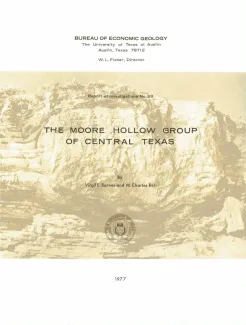Publication Details
Geolocation:
Get the Publication
Abstract/Description:
Middle and Upper Cambrian rocks and locally up to 90 feet of Lower Ordovician rocks in Central Texas, are here named the Moore Hollow Group. In ascending order, the Moore Hollow Group is composed of the Riley Formation (Hickory Sandstone, Cap Mountain Limestone, and Lion Mountain Sandstone Members) and the Wilberns Formation (Welge Sandstone, Morgan Creek Limestone, Point Peak, and San Saba Members).
A sequence of Dresbachian to earliest Ordovician faunas, as complete as any known in North America, was found during the field and laboratory work on this sequence of rocks. The mostly granular limestone of the Moore Hollow Group is composed dominantly of pelmatozoan debris; trilobite debris is abundant and in a few beds is dominant. These rocks accumulated in shallow water in a broad bay-like area.
The boundary between the Moore Hollow and overlying Ellenburger Group is identified using lithic evidence only. It is in a gradational sequence formed during continuous sedimentation, and in general the boundary is younger toward the shore. Within the Llano region the boundary between lithic types crosses the Cambrian-Ordovician boundary; consequently, Ordovician rocks are included in the Moore Hollow Group to the west and Cambrian rocks are included in the Ellenburger Group to the east.
Although the Moore Hollow Group is composed of distinctly mappable units in the Llano region, shoreward in the subsurface the carbonate rocks give way to terrigenous materials and the identity of the various units is no longer maintained. In the opposite direction in the subsurface, terrigenous units give way to carbonate rocks, a disconformity between the Riley and Wilberns Formations disappears, and dolomite becomes the principal carbonate of the Wilberns Formation.
